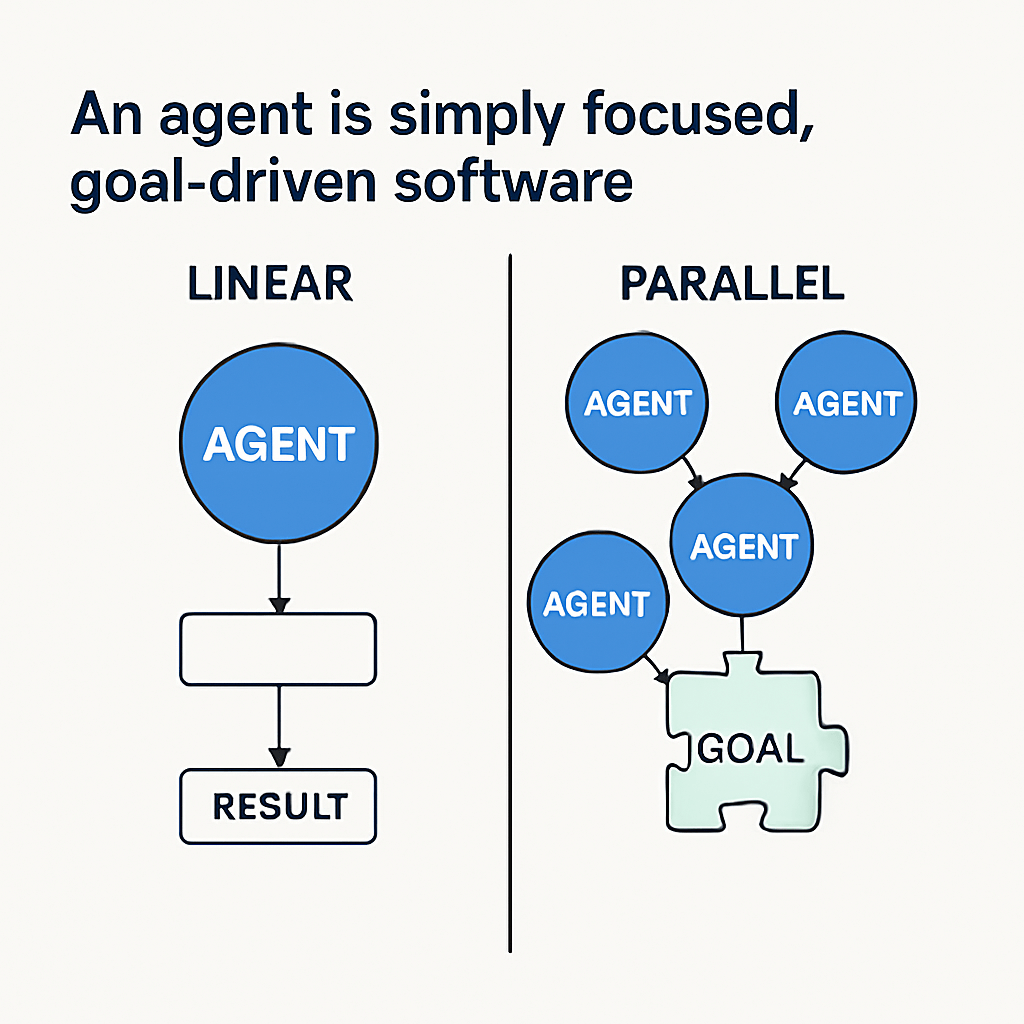By David Bell, Adam Brown and Stephen McArthur
Why AI-driven agent systems are finally in the spotlight and why the hype is justified (but not new).
Have you scrolled LinkedIn lately? If so, you’ve probably bumped into chatter about “AI agents”. Debates are buzzing around whether you need one, ten, or a hundred. Honestly, for anyone outside the research bubble, it might sound like a techy echo chamber. But you know what? Beneath all that noise, the idea is surprisingly simple and incredibly powerful.

Agents, Simplified
At its core, an agent is simply goal-focused software. Think of it as a specialised employee. It consumes data, does its job, and hands back results. Easy. But here’s the magic: put a few (or even a hundred) together, and these software agents can tackle projects far bigger than any single programme could handle alone.
A Tale of Two Architectures
Two recent papers highlight how agents can work wonders, each in a unique way.
Cognition recently introduced Devin AI, their autonomous AI coding agent and software engineer. This adopts a linear flow; almost an assembly line-style approach. Each agent passes work along to the next, refining and adding context step by step until a polished solution emerges. Think of it as a streamlined corporate workflow, where each department contributes an essential piece.
Then Anthropic introduced parallel agent swarms for performing research. Similar to dispatching a hundred expert consultants simultaneously, each addressing a different part of the same puzzle. Each returns with insights and a lead agent methodically assembles everything. The result is an incredibly thorough, yet time-effective, approach to compiling in-depth reports.
In some areas, the papers have sparked discussion as to which approach is best. But that misses the point. Two methods are presented, but there is one golden rule: select the way that best fits your real-world challenge.

Agents: The “New” Old Idea
Here’s the interesting part. While the applications for agents are growing, the concept is not completely new. Back in 1994, researchers Wooldridge and Jennings envisioned agents managing maintenance, optimising supply chains, and handling real-time monitoring. Our co-founder, Professor Stephen McArthur, took that vision and turned it into practical deployments across energy grids and critical infrastructure back in the late ’90s and early 2000s.
Even then, the key insight was clear. Use modular design. Give each piece of software a simple, well-defined role and an easy way to communicate with its neighbours. Then you can build systems flexibly, allowing for ever-changing requirements. You never have to rebuild from scratch. You can swap out older modules when a better option appears, add new ones as needed and the whole system continues smoothly.
Built for Change
For our clients, flexibility isn’t merely convenient; it’s essential. They manage plants where new sensors can provide new insights, regulations can change and market shifts redefine priorities. Locking them into rigid analytics is like trapping them in yesterday’s headlines. That’s exactly why our deckchair platform was built on agent principles from day one.
Every deckchair agent has a focused scope, transparently shares inputs and outputs and can be replaced the moment a better algorithm or richer data source arrives. It organises how data and AI tools work together so teams don’t have to, enabling adaptation without disruption.
Transparency Isn’t Just a Buzzword
The ability to understand this flow is important too. Audit trails aren’t nice to have; they’re critical. Engineers must clearly understand each step of the process, be able to add their domain expertise and feed insights directly back into the system. Transparency creates trust, allowing humans and AI to amplify each other instead of competing.
Debate or Diversification?
So, are industry professionals genuinely debating exactly how agent systems should operate? Possibly at tech conferences. But in the real world of the control rooms and operational centres, there’s rarely a strict “either-or” choice. Linear sequences, parallel operations and even traditional standalone models often coexist. Ultimately, the fundamental lesson of that old 1994 paper still holds true. Ensure each intelligent module has a clear purpose, communicates effectively, and remains easy to update when life inevitably changes course.
Overnight Success, Three Decades Later
Yes, agent systems might seem to have suddenly appeared everywhere. And yes, the roles they now perform have advanced wildly over the past two years. But remember, this overnight sensation has been quietly developing for thirty years. The flashy headlines? They’re merely shining a long-overdue spotlight on a robust idea that’s endured decades of messy reality checks. And honestly, the real breakthrough isn’t about how many agents you deploy, or whether they’re simple analytics or advanced LLMs. It’s about how quickly your entire team, both human and digital, can pivot when circumstances inevitably change again.

